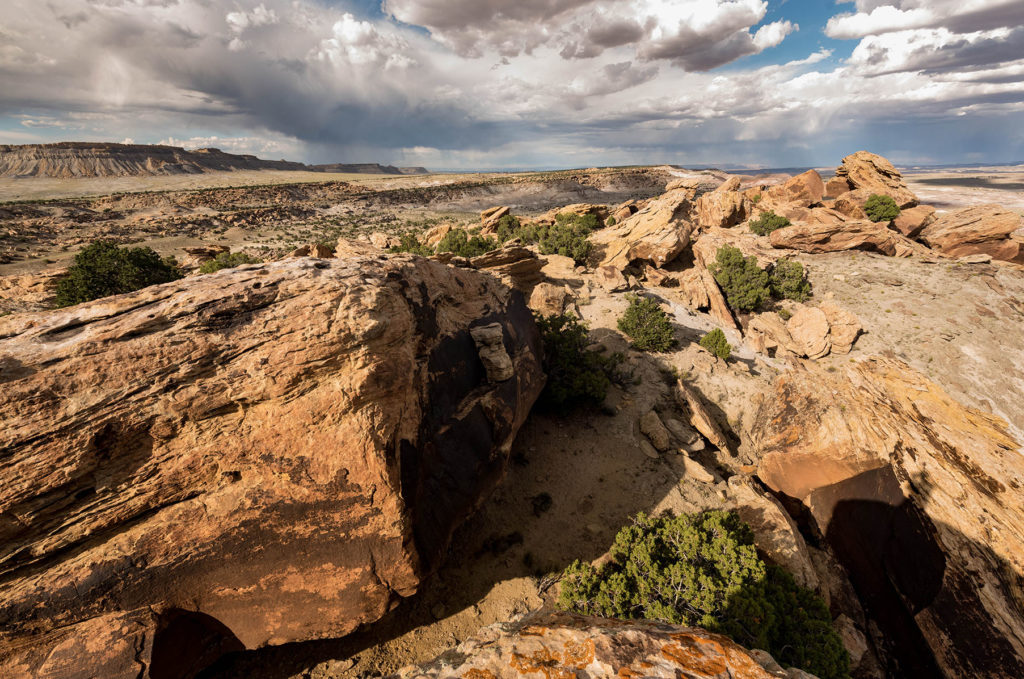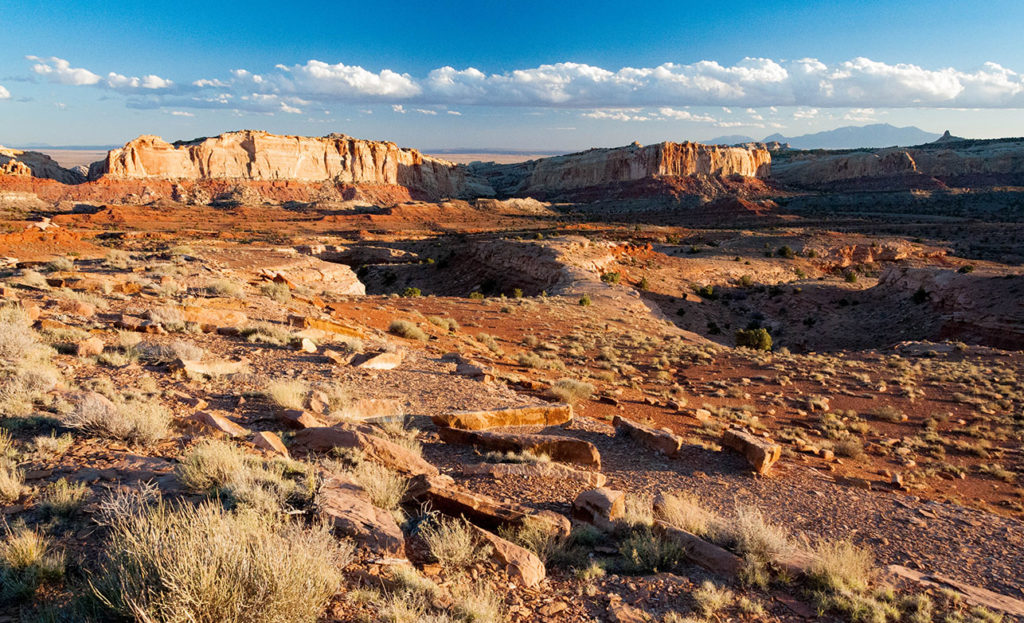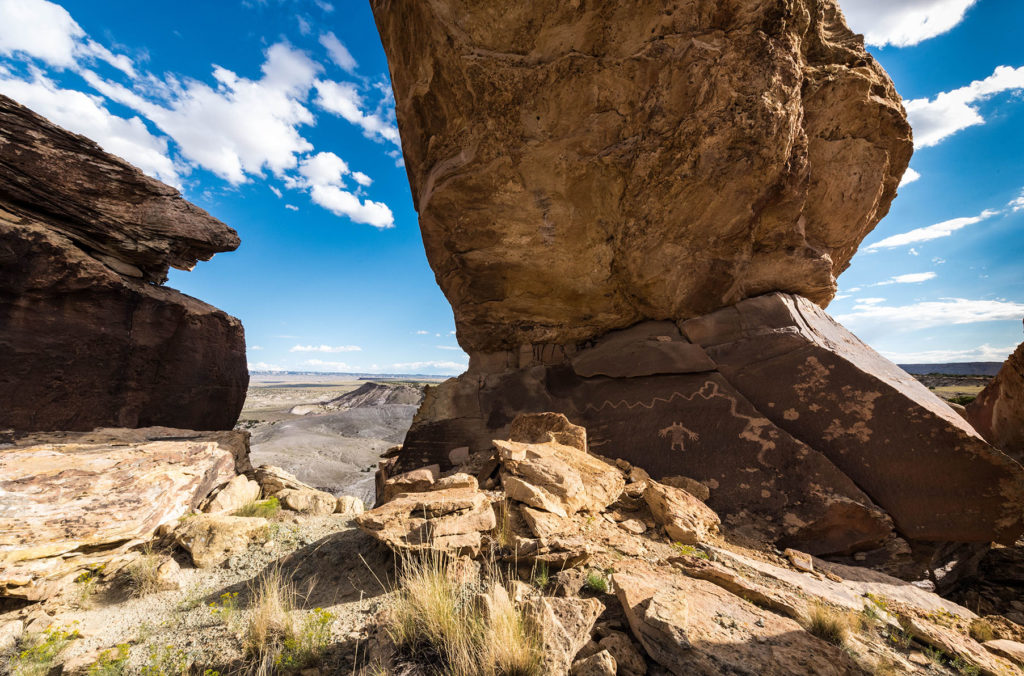Utah Rep. John Curtis and Sen. Orrin Hatch have introduced the Emery County Public Land Management Act of 2018 (H.R. 5727/S. 2809), legislation that would affect beloved southern Utah landscapes such as the San Rafael Swell and Labyrinth and Desolation Canyons.
The region includes nearly 1.4 million acres of land that richly deserves the wilderness designation that America’s Red Rock Wilderness Act would protect. It contains one of the largest, most intact, and still-unprotected blocks of wild public lands remaining in southern Utah. While the public lands within Emery County have been the subject of proposed legislation for the past 50 years, that legislation has never risen to a level worthy of these world-renowned landscapes. Unfortunately, what Hatch and Curtis have proposed is no exception.
Simply stated, there is little or no conservation gain in the legislation. It wouldn’t close a single off-road vehicle route, and it wouldn’t close any wild places to the threat of leasing. We understand that a goal of the bill is, in fact, precisely to prevent future conservation gains.

How Did We Get Here?
SUWA has worked to protect the San Rafael Swell, Labyrinth Canyon, and Desolation Canyon for 35 years. We’ve met with officials from Emery County countless times seeking common ground. Our work has also included litigation over motorized vehicle abuse, oil and gas leasing, and legislative fights to ensure that bad public lands bills never become law.
When Congress passed legislation in 2009 that included protections for wilderness and National Conservation Area (NCA) designations in Washington County, Utah, it seemed to us a propitious time to explore similar solutions in other counties. So SUWA, on behalf of the Utah Wilderness Coalition, approached the Emery County commissioners and agreed to split the cost of a neutral facilitator in the hope of reaching compromise on a public lands bill for the county.
A handful of their constituents bridled. The commissioners folded and reneged on the agreement. It became clear that our continued participation was a poor use of our time and resources. So we withdrew from a process that had become increasingly internal—commissioners talking to locals and to no one else. We told them to let us know when they had hammered out their proposal and that we remained committed to re-engaging and trying to reach an agreement. The county never re-engaged.
When this latest legislative effort for Emery County began, SUWA submitted a serious, good-faith compromise proposal. It would have removed significant acreages of land long proposed for wilderness designation in America’s Red Rock Wilderness Act, either outright or for a less-protective NCA designation. The county largely ignored our proposal.
The Utah congressional delegation refused to meaningfully negotiate areas, boundaries, or management language before it introduced the bill in May. While we continue to try to work with Curtis’s and Hatch’s offices, so far the legislation has strayed little from what Emery County proposed in the first place. Make no mistake, the bill that you see today represents a one-sided county proposal propped up by the Utah congressional delegation. It does not reflect any serious “stakeholder process” or negotiation with the organizations working on the ground to ensure protection of these public land treasures.
Less Than Meets the Eye
At first blush the Emery County bill’s wilderness and National Conservation Area acreages may seem impressive, but it doesn’t withstand even minimal scrutiny. This shortsighted legislation:
• Designates less BLM wilderness than is now protected as Wilderness Study Areas or Natural Areas.
• Wholly fails to protect remarkable and critical intact wild landscapes as wilderness; exacerbates motorized vehicle abuse by effectively enshrining an illegal travel plan and opening now-closed motorized routes.
• Exempts motorized travel from conservation area and wilderness management.
• Includes unprecedented giveaways to Utah in the form of cooperative management and public-purpose conveyances, handing over control of the southern San Rafael Reef—including areas such as Chute and Crack Canyons—to the state (the state would then most likely charge the public for visiting their public lands, with proceeds going to the state or Emery County).
• Removes existing WSA protection to facilitate coal mining.
• Allows the State of Utah to continue its federal court litigation seeking highway rights-of-way through newly-designated wilderness, instead of resolving RS 2477 issues.
• Authorizes a land exchange that fails to identify federal parcels that will be traded, fails to ensure protection of wilderness-quality lands and now-rescinded national monuments, and fails to require consultation with Native American tribes.
Opportunity Exists . . .
While efforts to develop meaningful wilderness legislation for public lands within Emery County have failed in the past, and while we have thus far seen little willingness to make the changes necessary to address our concerns, SUWA remains committed to the goal of protecting these remarkable wilderness-quality lands in perpetuity for the benefit of all Americans. But genuine protection, and thus SUWA’s support, will require major changes to the bill as introduced—changes in both legislative language and the boundaries of conservation designations. Of the utmost importance, the bill cannot enshrine motorized vehicle use as it now proposes, and must protect the entirety of the Muddy Creek region, Labyrinth Canyon, and the San Rafael Badlands. Here’s what we’d need to call this a good bill.
Motorized Vehicle Use
The Emery County bill takes the dangerous and unprecedented approach of excluding (i.e., “cherry-stemming”) all motorized routes and trails from the NCA and wilderness areas, listing them as “Cherry Stemmed Routes” on the legislative map. That effectively ensures that routes in an illegal travel plan will remain open in perpetuity, and drastically undermines a January 2017 settlement between conservationists, the Trump administration, and off-road vehicle advocates. The settlement requires the Bureau of Land Management (BLM) to produce new motorized vehicle travel plans for the San Rafael area that consider impacts to natural and cultural resources.
Furthermore, the Hatch-Curtis legislation creates a bizarre and difficult management situation for the BLM. The agency would have to manage motorized travel without consideration of, or consistency with, the underlying purposes of the NCA and wilderness designations. This egregious road grab makes a mockery of the so-called wilderness and NCAs in the legislation; if it’s not fixed, the bill is a non-starter.

Muddy Creek Wilderness
The Muddy Creek landscape represents every landform found in the San Rafael region: 200 million years of geologic history from the Permian Coconino Sandstone to Tertiary igneous intrusions folded and carved into towering mesas, sweeping badlands, impassable reefs, slickrock domes and canyons, and black walls of desert varnish. Reaching from the interior of the Swell to the northeast corner of Capitol Reef National Park, Muddy Creek is the second largest block of undeveloped BLM land in Utah, so you’d think its inclusion in a good wilderness bill would be a no-brainer. But this, to repeat, is not even close to a good wilderness bill.
The Emery County bill fails to protect the majority of this wild landscape. Of the 239,000-acre Muddy Creek proposed wilderness—all of which the BLM agrees qualifies as wilderness—the legislation only designates the 30,500-acre Muddy Creek Wilderness Study Area and 8,700 acres of the Muddy Creek Natural Area as wilderness. Even the proposed NCA for this area arbitrarily stops at the southern boundary of Emery County, ignoring the contiguous, wilderness landscape that continues into Wayne County. To give the Muddy Creek region the lasting preservation it deserves, the legislation must designate all 239,000 qualifying acres as wilderness. Nothing less will ensure that this wilderness treasure is preserved in its entirety without the intrusion of habitat-fragmenting off-road vehicle routes.

Labyrinth Canyon Wilderness
This world-class stretch of flat water on the Green River is unbroken by rapids or falls on its 50-mile journey from Red Wash near Trin-Alcove Bend to Canyonlands National Park. Labyrinth offers spectacular opportunities for quiet recreation and sightseeing, provides critical wildlife and plant habitat, and contains a wealth of prehistoric cultural resources. The Emery County bill proposes to protect a tiny portion of the western side of Labyrinth Canyon as designated wilderness, but fails to protect most of the Emery County side of the canyon and, absurdly, envisions no protection at all for the opposite side. Why? It falls in Grand County, never mind that intact ecosystems have no regard for the boundaries of county fiefdoms.
To protect the unparalleled solitude of Labyrinth Canyon for our children and theirs, the legislation must include an additional 138,000 acres of designated wilderness in the canyon—76,000 acres in Emery County, 62,000 in Grand County. In addition, the bill must designate as wilderness the western portion which the Emery County measure now proposes as an NCA. Such a wilderness designation will ensure that the entirety of Labyrinth Canyon and its side canyons are protected within both Emery and Grand Counties—from Red Wash down to Canyonlands.

San Rafael Badlands NCA
The San Rafael Badlands area constitutes the western reach of the San Rafael Swell. It holds a diversity of landscapes rich in cultural resources, scenic vistas, and geologic wonders, encompassing such places as Molen Reef, Eagle Canyon, Rock Canyon, Cedar Mountain, and the Mussentuchit Badlands (pronounced “mustn’t touch it”). This rugged landscape is studded with mesas, buttes, and igneous intrusions painted in a brilliant kaleidoscope of desert colors.
In its present form, the Emery County bill fails to protect any of the sensitive landscapes of these badlands. To truly protect this remote and rugged cultural and natural treasure, the legislation must designate a 158,000-acre San Rafael Badlands NCA in a stand-alone legislative section with explicit language “to conserve, protect, and enhance for the benefit and enjoyment of present and future generations the cultural, ecological, wildlife, natural, scenic, educational, and scientific resources” of the NCA. A withdrawal from mineral leasing is essential, too; nothing short of that will ensure that this remote, culturally-rich landscape is safe from future oil and gas leasing. Leasing is a continual threat in this region even though its energy resources are considered of low potential.
. . . But History Most Likely Repeats Itself
All of these failings are mortal by themselves, but they are not alone. The legislation is laden with other highly objectionable provisions involving state management of high-value public land, state-federal land exchanges, release of a wilderness study area to permit coal mining, and state road claims. Before the bill can gain conservationists’ support, it must cure these deficiencies.
If lessons from the past are any indication, the Emery County bill will meet the fate of all other bad public lands proposals for the San Rafael Swell—either dying in a congressional fight or withering on the vine. It will take significant leadership from the Utah delegation, and significant compromise by Emery County officials, to make this legislation worthy of the landscapes it would affect. So far, we’ve seen no willingness to make the changes necessary to garner our support or the leadership necessary to push Emery County to the negotiating table. If that remains the case, as it likely will, we will do everything in our power to ensure that this bill never becomes law. With your help, this county-driven, one-sided legislation will meet the fate of so many terrible Emery County bills before.
—Jen Ujifusa and Neal Clark
(From Redrock Wilderness newsletter, summer 2018 issue)

